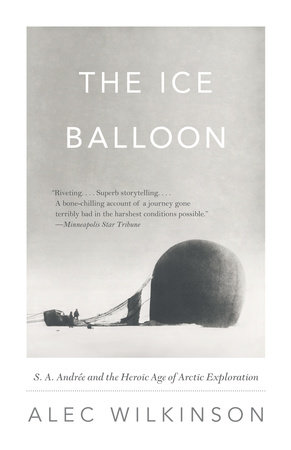Q: What made S. A. Andree’s expedition to the Arctic in 1897 unique?
A: Several things. To begin with, he was the first person to attempt to fly to the north pole, and the first to fly in the Arctic. The first to use the air as a means of discovery. Beforehand, for hundreds of years, the Pole had been approached only by men in ships which the ice often carved up practically into splinters and on sledges and neither had taken anyone far enough. In fact, the Pole was still so elusive that until the early Twentieth century no one even knew what was there. (It is difficult to imagine that even as late as the early part of the last century, many scientists believed that the Pole was encircled by a temperate sea; its warmth is what caused icebergs to separate themselves from the larger body of ice).
Andree was not so much an explorer in a line of explorers, using their methods and refining them, but a pioneer, the advance figure of a new means of approach. A visionary. Finally, he was the first explorer to head into the Arctic unencumbered by notions of the Romantic age, which had shaped thoughts and images and impressions of the Arctic for hundreds of years as a place of severe purity, an outpost of the god seeking world, a sanctified ground.
Q: Who was Andree and what drew you to his story?
A: Andree was a Swedish engineer enraptured by the notions and practical means of flight. He saw the upper atmosphere as a broad highway from the west toward the east, following the winds, over which balloons could travel with passengers and freight, faster than ships and to places ships and sledges could never reach. He was a science-minded prophet, absorbed with imagining a future almost entirely different from the one his contemporaries held in mind. Rather than spend months of arduous, even fatal toil trying to reach the Pole through the ice, he proposed flying to it in fewer than two days and settling for all time the mystery of what circumstances, what kind of territory, it encompassed.
My wife found a photograph of his balloon in a small, obscure book on ballooning, which had been on the shelf at my friend William Maxwell’s house. She took it down, saw the photograph, and said, “Have you ever heard of S.A. Andree?” The photograph—of the balloon on its side in a white landscape—seemed an impossible image, as likely to be truthful as a photograph of an airplane on the moon. I assumed it was a stunt, a Victorian prank.
Q: In terms of Arctic exploration, where does Andree’s journey in 1897 fit in to history?
A: He stands, by means of the uniqueness of his undertaking, both inside and outside history. An exotic, a one-off. A British military officer of the period described Andree’s voyage as the most original and remarkable journey ever made into the Arctic, and for daring, and visionary thinking the figure Andree was most often compared to was Columbus. He proved to be, also, I suppose, a species of worldly clairvoyant. When the Pole was finally observed, it was not from the deck of a ship, or from behind a sledge, but from the cockpit of an airship, precisely the vantage that would have been Andree’s.
Q: The balloon took off for the Arctic on July 11, 1897. 33 years went by before the discovery of Andree’s remains and diaries. What went wrong?
A: They sailed over the horizon and disappeared, becoming the first men ever to be lost in the air. Since they had penetrated territory no one had ever seen before, there was no means of pursuing them or rescuing them or bringing them any comfort. No one was even sure what direction they had flown in once they were lost to sight, since the winds never blew in a straight line. The world could only wait for their return. Days passed with only slight word, from messages carried by pigeons released from the balloon, then weeks, then a curtain fell and concealed them.
Three days into their flight, roughly at the time Andree had predicted arriving at the Pole, ice from fog formed on the balloon and brought it down. They were then three men on a forced march through territory as inhospitable and forbidding as any in the world. “The realm of death” is how one explorer described the Arctic.
Q: There are some truly amazing photographs of the balloon in the Arctic. What can you tell us about those photos?
A: The photographs were made by Nils Strindberg, the expedition’s photographer, and a relation of the writer August Strindberg. Strindberg had a better than typical eye—he had won a photography contest once and had shown photographs he had made in the Arctic on an earlier trip. As the expedition got underway he took a number of images, although fewer and fewer as they traveled on the ice, since the work of doing so was so fatiguing and so relentless that they stopped more or less only to eat and to rest and he hadn’t the energy, apparently, to unpack and set up his camera. Even so, he took something like a hundred photographs, which were not developed until 1933, when the film was found with his remains. No record of the kind exists for any other Arctic expedition. The effect of seeing the images from what was described as a death march across the ice was for the survivors as if Andree and Fraenkel and Strindberg had been seen in the Afterlife.
Q: You include some fun tidbits throughout such as how on one of Andree’s test flights he threw cards out of the balloon asking anyone who found them to send them back to him so that he could tell exactly where he had been. What primary sources were you able to get access to in researching this book?
A: Mainly his diaries and the records he kept of his travels.
Q: What has Andree’s legacy been?
A: Well, no one ever tried to fly a balloon to the North Pole again, but he had introduced the idea that the air was the means of access to the top of the world. Andree was a fanatic of a kind and his demise may have put off others who might have tried to overcome the difficulties of reaching the Pole by using a balloon. Nevertheless, when the Pole was finally discovered—that is, by someone whose account is not disputed—it was seen from an airship, as Andree had hoped to see it.
Q: While much of the book takes place abroad, you end the book with a discovery you made in NYC’s Central Park. Tell us about that.
A: In 1876, as a young man, Andree had sailed to America to attend the Centennial Exposition in Philadelphia which had been organized to celebrate the anniversary of the signing of the Declaration of Independence. At the Exposition all the world’s new technologies were on display and Andree was obsessed with practical science. He found a job as the janitor at the Swedish Pavilion, which allowed him to wander wherever he cared to at the fair. The Swedish Pavilion was a tech built house, the first one ever built, and Andree slept in a bedroom upstairs. After the fair the house was taken down and put up in Central Park. When I returned from visiting Sweden it occurred to me to wonder what the Pavilion had looked like and when I saw a photograph of it I was brought up short by the awareness that I had passed the building, which is near my apartment, nearly every day for twenty years. I still like to go there and imagine Andree, tall and blond and full of promise, consumed with daring ideas for the future.














